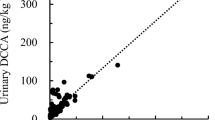Summary
Natural pyrethrins from insecticidal pyrethrum extract and pyrethroids (e.g. allethrin, tetramethrin, permethrin, cyphenothrin, cypermethrin, cyfluthrin) are active ingredients in insecticidal formulations such as powder, sprays, impregnated paper for electro-evaporators, mosquito coils, and solutions for wood treatment, all mainly intended for indoor use. Some commercial preparations contain also non-pyrethroid insecticides, such as dichlorovos, propoxur, or phoxim, and piperonyl butoxid as synergist. High-resolution gas-chromatography with oncolumn injection and FID and ECD detection is employed for the analysis of these insecticides in commercial formulations, in air during and after indoor application, and as residues on surfaces. The total input of pyrethroids into a large room amounts to 1 to 30 mg. The concentrations of the pyrethrins and pyrethroids in air (2 to 300 μg/m3) and their deposition on surfaces (up to 1000 μg/m2) reveal possible exposure of humans by inhalation (e.g. 30 μg allethrin or 60 μg tetramethrin) or by skin resorption (e.g. 200 μg allethrin and up to 1000 μg tetramethrin). The insecticides deposited on surfaces and some readily formed transformation products persist for 60 h or longer.
Similar content being viewed by others
References
Casida JE (1980) Environmental Health Perspectives 34:189–202
Soderlund DM, Casida JE (1977) Pestic Biochem Physiol 7:391–401
Murphy SD (1986) Toxic effects of pesticides. In: Casarett LJ, Doull J (eds) Toxicology. Macmillan, New York, pp 519–581
Ellenhorn MJ, Barceloux DG (1988) Medical toxicology, Chap. 38: Pesticides. Elsevier, New York, pp 1067–1108
Class TJ, Ando T, Casida JE (1990) J Agric Food Chem 38:529–537
Ruzo LO (1982) Photochemical reactions of the synthetic pyrethroids. In: Hutson DH, Roberts TR (eds) Progress in pesticide biochemistry, vol 2. Wiley, New York, pp 1–33
Perkow W (1988) Wirksubstanzen der Pflanzenschutz- und Schädlingsbekämpfungsmittel, 2nd edn. Parey, Berlin
Class TJ (1991) J High Res Chromatogr 14:48–51
Steigleder GK (1983) Dermatologie und Venerologie. 4th ed Thieme, Stuttgart, p 141
Author information
Authors and Affiliations
Rights and permissions
About this article
Cite this article
Class, T.J., Kintrup, J. Pyrethroids as household insecticides: analysis, indoor exposure and persistence. Fresenius J Anal Chem 340, 446–453 (1991). https://doi.org/10.1007/BF00322420
Received:
Revised:
Issue Date:
DOI: https://doi.org/10.1007/BF00322420




